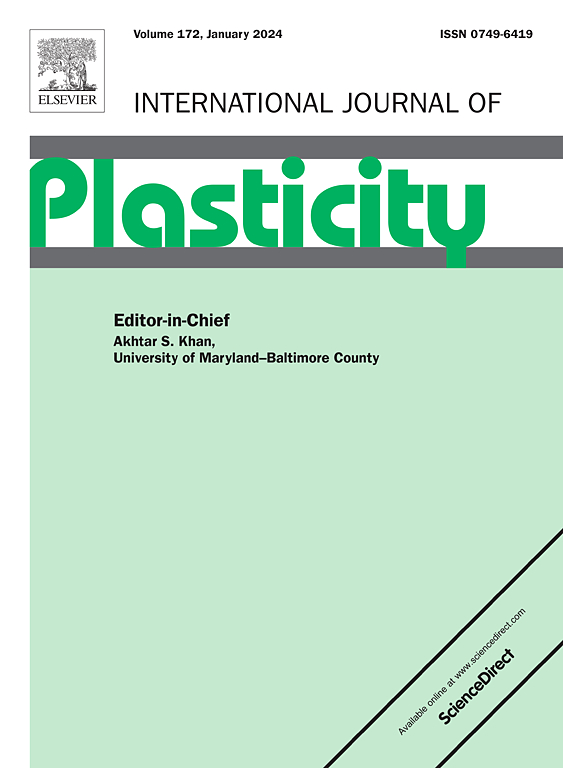Role of recovery in the microstructure development and mechanical behavior of a ductile Mg-Zn-Nd-Y-Zr alloy: an analysis using EBSD data and crystal plasticity simulations
IF 12.8
1区 材料科学
Q1 ENGINEERING, MECHANICAL
引用次数: 0
Abstract
A highly deformable Mg-Zn-Nd-Y-Zr alloy was investigated in terms of anisotropic and temperature-dependent mechanical behavior, with an emphasis on the microstructural changes. Uniaxial tension tests were conducted along the rolling (RD) and transverse (TD) directions at room temperature (298 K) and at 498 K, during which a series of ex-situ EBSD scans were obtained. In addition to quantitative texture analysis based on the EBSD scans, the relative contributions of various slip systems were estimated via slip trace analysis. Moreover, the effect of static recovery was investigated by additional two-step tension tests with intermediate annealing at 498 K. The microstructure development due to recovery was analyzed via ex-situ EBSD scans by analyzing the grain average misorientation, kernel average misorientation, and in-grain misorientation axis evolution. Experimental results were interpreted using crystal plasticity simulations based on the incremental elasto-visco-plastic self-consistent polycrystal model (ΔEVPSC). Remarkably, a single set of parameters sufficed to describe the complex anisotropic and temperature-dependent behavior of the Mg-Zn-Nd-Y-Zr alloy by utilizing a dislocation density-based hardening model (DDH). The recovery, mainly of non-basal dislocations, significantly affected the flow stress responses, which allowed not only to describe the hardening behavior but also the anisotropy, characterized by the R-value and texture.
恢复在延展性Mg-Zn-Nd-Y-Zr合金微观组织发展和力学行为中的作用:利用EBSD数据和晶体塑性模拟进行分析
研究了一种高变形Mg-Zn-Nd-Y-Zr合金的各向异性和温度相关力学行为,重点研究了其显微组织变化。在室温(298 K)和498 K下进行了沿滚动(RD)和横向(TD)方向的单轴拉伸试验,在此期间获得了一系列非原位EBSD扫描。除了基于EBSD扫描的定量织构分析外,还通过滑移迹分析估计了各种滑移体系的相对贡献。此外,通过在498 K温度下进行中间退火的附加两步拉伸试验,研究了静态恢复的影响。通过非原位EBSD扫描,分析了晶粒平均取向偏差、核平均取向偏差和晶粒内取向偏差轴的演变,分析了恢复后的微观组织发展。实验结果采用基于增量弹粘塑性自洽多晶模型(ΔEVPSC)的晶体塑性模拟进行解释。值得注意的是,利用基于位错密度的硬化模型(DDH),一组参数足以描述Mg-Zn-Nd-Y-Zr合金复杂的各向异性和温度依赖行为。非基底位错的恢复显著影响流变应力响应,这不仅可以描述硬化行为,还可以描述各向异性,以r值和织构为特征。
本文章由计算机程序翻译,如有差异,请以英文原文为准。
求助全文
约1分钟内获得全文
求助全文
来源期刊

International Journal of Plasticity
工程技术-材料科学:综合
CiteScore
15.30
自引率
26.50%
发文量
256
审稿时长
46 days
期刊介绍:
International Journal of Plasticity aims to present original research encompassing all facets of plastic deformation, damage, and fracture behavior in both isotropic and anisotropic solids. This includes exploring the thermodynamics of plasticity and fracture, continuum theory, and macroscopic as well as microscopic phenomena.
Topics of interest span the plastic behavior of single crystals and polycrystalline metals, ceramics, rocks, soils, composites, nanocrystalline and microelectronics materials, shape memory alloys, ferroelectric ceramics, thin films, and polymers. Additionally, the journal covers plasticity aspects of failure and fracture mechanics. Contributions involving significant experimental, numerical, or theoretical advancements that enhance the understanding of the plastic behavior of solids are particularly valued. Papers addressing the modeling of finite nonlinear elastic deformation, bearing similarities to the modeling of plastic deformation, are also welcomed.
 求助内容:
求助内容: 应助结果提醒方式:
应助结果提醒方式:


